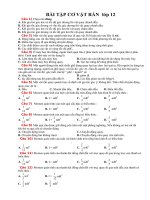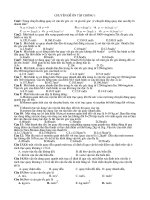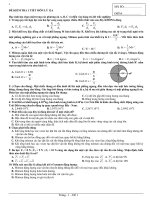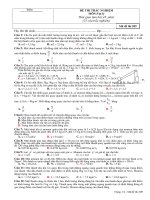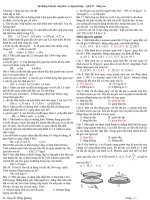slide cơ học vật chất rắn chapter 4 new material behavior linear elastic solid
Bạn đang xem bản rút gọn của tài liệu. Xem và tải ngay bản đầy đủ của tài liệu tại đây (4.12 MB, 27 trang )
.c
om
ng
co
an
th
cu
u
du
o
ng
Chapter 4: Material Behavior – Linear
elastic solid
TDT University -‐ 2015
CuuDuongThanCong.com
/>
.c
om
h"p://incos.tdt.edu.vn
4.1 Material characterization
co
ng
4.2 Linear elastic material – Hooke’s law
an
4.3 Physical meaning of elastic module
cu
u
du
o
ng
th
4.4 Thermo-elastic constitutive relations
2
CuuDuongThanCong.com
/>
.c
om
h"p://incos.tdt.edu.vn
4.1 Material characterization
co
an
4.3 Physical meaning of elastic module
ng
4.2 Linear elastic material – Hooke’s law
cu
u
du
o
ng
th
4.4 Thermo-elastic constitutive relations
3
CuuDuongThanCong.com
/>
h"p://incos.tdt.edu.vn
⎧ ∂σ x ∂τ yx ∂τ zx
⎪ ∂x + ∂y + ∂z + Fx = 0
⎪
⎪∂τ xy ∂σ y ∂τ zy
+
+
+ Fy = 0
⎨
∂
x
∂
y
∂
z
⎪
⎪ ∂τ
∂τ yz ∂σ z
xz
+
+
+ Fz = 0
⎪
∂y
∂z
⎩ ∂x
ng
co
an
th
So far, we studied
∂u
∂v
∂w
⎧
ε
=
,
ε
=
,
ε
=
y
z
⎪ x ∂x
∂y
∂z
⎪
∂u ∂v
∂v ∂w
⎪
γ
=
+
,
γ
=
+
,
⎨ xy
yz
∂
y
∂
x
∂
z
∂
y
⎪
⎪
∂w ∂u
γ
=
+
⎪ zx
∂
x
∂z
⎩
.c
om
4.1 Material characterization
+ 3 equilibrium equations
du
o
ng
+ 6 strain-displacement equations
cu
u
⎧ ∂ 2 ex ∂ 2 e y
∂ 2exy
∂ 2 ex
∂ ⎛ ∂eyz ∂ezx ∂exy ⎞
=
+
+
+
=
2
;
⎪ 2
⎜−
⎟
2
∂
y
∂
z
∂
x
∂
x
∂
y
∂
z
∂
y
∂
x
∂
x
∂
y
⎝
⎠
⎪ 2
2
2
2
∂ eyz
∂ ey
∂ ⎛ ∂ezx ∂exy ∂e yz ⎞
⎪ ∂ e y ∂ ez
+
=
2
;
=
+
+
⎨ 2
⎜−
⎟
2
∂
z
∂
y
∂
y
∂
z
∂
z
∂
x
∂
y
∂
y
∂
z
∂
x
⎝
⎠
⎪ 2
2
2
2
∂ ⎛ ∂exy ∂e yz ∂ezx ⎞
⎪ ∂ ez + ∂ ex = 2 ∂ ezx ; ∂ ez
=
+
+
⎜−
⎟
⎪ ∂x 2 ∂z 2
∂z∂x
∂
x
∂
y
∂
z
∂
z
∂
x
∂
y
⎝
⎠
⎩
+ 6 compatibility equation
CuuDuongThanCong.com
/>
4
h"p://incos.tdt.edu.vn
.c
om
4.1 Material characterization
ng
In which, 6 compatibility equations represent only 3 independent relations, and
these equations are needed only ensure that a given strain field will produce singlevalued continuous displacements. => No need for the general problems
th
an
co
Excluding the compatibility relations, it is found that we have 9 field equations. The
unknowns in these equations include 3 displacement components, 6 components of
strain, and 6 stress components => total 15 unknowns.
cu
u
du
o
ng
So far, 9 equations are not sufficient to solve for 15 unknowns.
• We need additional field equations
• The material response => the relationship between the strains and stresses.
5
CuuDuongThanCong.com
/>
h"p://incos.tdt.edu.vn
.c
om
4.1 Material characterization
u
du
o
ng
Solid Recovers Original Configuration When Loads Are Removed
Linear Relation Between Stress and Strain
Neglect Rate and History Dependent Behavior
Include Only Mechanical Loadings
Thermal, Electrical, Pore-Pressure, and Other Loadings Can Also Be Included
As Special Cases
cu
•
•
•
•
•
th
an
co
ng
Mechanical behavior of solids is normally defined by constitutive stress-strain
relations. Commonly, these relations express the stress as a function of the strain,
strain rate, strain history, temperature, and material properties. Here, we use the
Linear Elastic Constitutive Solid Model in which the Stress-Strain Relations are
under the Assumptions:
6
CuuDuongThanCong.com
/>
h"p://incos.tdt.edu.vn
.c
om
σ
co
ng
4.1 Material characterization
an
Typical One-Dimensional
Tensile Sample
Cast Iron
Aluminum
u
du
o
ng
th
Stress-Strain Behavior
Steel
cu
ε
Applicable Region for
Linear Elastic Behavior
σ = Eε
7
CuuDuongThanCong.com
/>
.c
om
h"p://incos.tdt.edu.vn
4.1 Material characterization
an
4.3 Physical meaning of elastic module
co
ng
4.2 Linear elastic material – Hooke’s law
cu
u
du
o
ng
th
4.4 Thermo-elastic constitutive relations
8
CuuDuongThanCong.com
/>
h"p://incos.tdt.edu.vn
σ ij = Cijkmε km
C1113
C1211
C1212
C1213
C1311
C1312
C1122
C1123
C1221
C1222
C1223
C1321
C1322
C1132
C1133
C1231
C1232
C1233
C1331
C1332
co
ng
C1112
an
C3123 C3221 C3222
C3133 C3231 C3232
du
o
C3122
C3132
ng
th
C2132 C2133 C2231 C2232 C2233 C2331 C2332
C3112 C3113 C3211 C3212 C3213 C3311 C3312
C3223 C3321 C3322
C3233 C3331 C3332
C1313 ⎤
C1323 ⎥⎥
C1333 ⎥
⎥
C2313 ⎥ ⎡ε11 ε12 ε13 ⎤
C2323 ⎥ : ⎢⎢ε 21 ε 22 ε 23 ⎥⎥
⎥
C2333 ⎥ ⎢⎣ε 31 ε 32 ε 33 ⎥⎦
C3313 ⎥
⎥
C3323 ⎥
C3333 ⎥⎦
C1122 C1133 C1112 C1113 C1123 ⎤ ⎡ ε11 ⎤
C2222 C2233 C2212 C2213 C2223 ⎥⎥ ⎢⎢ ε 22 ⎥⎥
C3322 C3333 C3312 C3313 C3323 ⎥ ⎢ ε 33 ⎥
⎥⎢
⎥
C1222 C1233 C1212 C1213 C1223 ⎥ ⎢ 2ε12 ⎥
C1322 C1333 C1312 C1313 C1323 ⎥ ⎢ 2ε13 ⎥
⎥⎢
⎥
C2322 C2333 C2312 C2313 C2323 ⎥⎦ ⎢⎣ 2ε 23 ⎥⎦
u
⎡σ 11 ⎤ ⎡ C1111
⎢σ ⎥ ⎢C
⎢ 22 ⎥ ⎢ 2211
⎢σ 33 ⎥ ⎢C3311
⎢ ⎥=⎢
⎢σ 12 ⎥ ⎢ C1211
⎢σ 13 ⎥ ⎢ C1311
⎢ ⎥ ⎢
⎢⎣σ 23 ⎥⎦ ⎢⎣C2311
( K , M = 1, 2,3, 4,5, 6)
C2112 C2113 C2211 C2212 C2213 C2311 C2312
C2122 C2123 C2221 C2222 C2223 C2321 C2322
cu
⎡σ 11 σ 12
⎢σ
⎢ 21 σ 22
⎢⎣σ 31 σ 32
⎡ C1111
⎢C
⎢ 1121
⎢ C1131
⎢
σ 13 ⎤ ⎢C2111
σ 23 ⎥⎥ = ⎢C2121
⎢
σ 33 ⎥⎦ ⎢C2131
⎢C
⎢ 3111
⎢C3121
⎢C
⎣ 3131
σ K = CKM ε M
.c
om
4.2 Linear elastic material – Hooke’s law
CuuDuongThanCong.com
/>
9
h"p://incos.tdt.edu.vn
4.2 Linear elastic material – Hooke’s law
with
Cijkl = C jikl ; Cijkl = Cijlk
du
o
( Due to the symmetry of
stress and strain tensors)
ng
th
an
co
σ ij = Cijkl ekl
ng
.c
om
⎧σ x = C11ex + C12e y + C13ez + 2C14exy + 2C15e yz + 2C16ezx
⎪
⎪σ y = C21ex + C22e y + C23ez + 2C24exy + 2C25e yz + 2C26ezx
⎪σ = C e + C e + C e + 2C e + 2C e + 2C e
31 x
32 y
33 z
34 xy
35 yz
36 zx
⎪ z
⎨
⎪τ xy = C41ex + C42e y + C43ez + 2C44exy + 2C45e yz + 2C46ezx
⎪τ = C e + C e + C e + 2C e + 2C e + 2C e
51 x
52 y
53 z
54 xy
55 yz
56 zx
⎪ yz
⎪⎩τ zx = C61ex + C62e y + C63ez + 2C64exy + 2C65e yz + 2C66ezx
cu
u
⎡σ x ⎤ ⎡ C11 C12
⎢σ ⎥ ⎢C
⋅
⎢ y ⎥ ⎢ 21
⎢σ ⎥ ⎢ ⋅
⋅
or ⎢ z ⎥ = ⎢
⋅
⎢τ xy ⎥ ⎢ ⋅
⎢τ yz ⎥ ⎢ ⋅
⋅
⎢ ⎥ ⎢
⎣τ zx ⎦ ⎣C61 ⋅
CuuDuongThanCong.com
⋅ ⋅ ⋅ C16 ⎤ ⎡ ex ⎤
⋅ ⋅ ⋅ ⋅ ⎥ ⎢ ey ⎥
⎥⎢
⎥
⋅ ⋅ ⋅ ⋅ ⎥ ⎢ ez ⎥
⎥⎢
⎥
⋅ ⋅ ⋅ ⋅ ⎥ ⎢ 2exy ⎥
⋅ ⋅ ⋅ ⋅ ⎥ ⎢ 2eyz ⎥
⎥⎢
⎥
⋅ ⋅ ⋅ C66 ⎦ ⎣ 2ezx ⎦
/>
36 Independent
Elastic Constants
10
h"p://incos.tdt.edu.vn
.c
om
4.2 Linear elastic material – Hooke’s law
(Body-Centered
Crystal)
du
o
Typical Wood
Structure
ng
th
an
co
ng
Anisotropy - Differences in material properties under different directions.
Materials like wood, crystalline minerals, fiber-reinforced composites have such
behavior.
(Hexagonal
Crystal)
(Fiber Reinforced
Composite)
cu
u
Nonhomogeneity - Spatial differences in material properties. Soil materials in
the earth vary with depth, and new functionally graded materials (FGM’s) are now
being developed with deliberate spatial variation in elastic properties to produce
desirable behaviors.
Gradation Direction
11
CuuDuongThanCong.com
/>
h"p://incos.tdt.edu.vn
4.2 Linear elastic material – Hooke’s law
.c
om
Isotropic Materials
ng
Although many materials exhibit non-homogeneous and anisotropic behavior, we
will primarily restrict our study to isotropic solids. For this case, material response
is independent of coordinate rotation
co
Cijkl = QimQ jn Qkp Qlq Cmnpq
(prove)
an
Cijkl = αδ ijδ kl + βδ ik δ jl + γδ ilδ jk
σ ij = ( αδij δkl + βδik δ jl + γδil δ jk ) ekl = αekk δij + βeij + γeij
Generalized Hooke’s Law
du
o
σ ij = λ ekk δ ij + 2µ eij
ng
th
σ ij = Cijkl ekl
cu
u
⎧σ x = λ ( ex + ey + ez ) + 2µex ; σ y = λ ( ex + e y + ez ) + 2µe y
⎪
⎪
⎨σ z = λ ( ex + ey + ez ) + 2µez
⎪
⎪⎩ τ xy = 2µexy ; τ yz = 2µeyz ; τ zx = 2µezx
λ - Lamé’s constant
µ - shear modulus or modulus of rigidity
CuuDuongThanCong.com
/>
12
h"p://incos.tdt.edu.vn
4.2 Linear elastic material – Hooke’s law
.c
om
Prove
Cijkl = QimQ jn Qkp Qlq Cmnpq
co
ng
Cijkl = αδ ijδ kl + βδ ik δ jl + γδ ilδ jk
an
α ′δ ij′δ kl′ + β ′δ ik′ δ ′jl + γ ′δ il′δ ′jk = QimQ jnQkpQlq (αδ mnδ pq + βδ mpδ nq + γδ mqδ np )
th
= α QimQ jmQkpQlp + β QimQ jnQkmQln + γ QimQ jnQknQlm
du
o
ng
= αδ ijδ kl + βδ ikδ jl + γδ ilδ jk
u
′ = α ′δ ij′δ kl′ + β ′δ ik′ δ ′jl + γ ′δ il′δ ′jk
Cijkl
cu
Cijkl = αδ ijδ kl + βδ ik δ jl + γδ ilδ jk
13
CuuDuongThanCong.com
/>
h"p://incos.tdt.edu.vn
4.2 Linear elastic material – Hooke’s law
.c
om
Isotropic Materials
1
⎡σ x −ν (σ y + σ z ) ⎤⎦
Inverted Form - Strain in Terms of Stress
E⎣
1
⎡σ y −ν (σ z + σ x ) ⎤⎦
e
=
y
σ kk = ( 3λ + 2µ ) ekk
σ ij = λ ekk δ ij + 2µ eij
E⎣
1
ez = ⎡⎣σ z −ν (σ x + σ y ) ⎤⎦
E
⎞
1 ⎛
λ
eij =
σ ij −
σ kkδ ij ⎟
1 +ν
1
e
=
τ
=
τ xy
2 µ ⎜⎝
3λ + 2 µ
⎠
xy
xy
E
2µ
1 +ν
1
e
=
τ
=
τ yz
yz
yz
1 +ν
ν
E
2
µ
eij =
σ ij − σ kkδ ij
E
E
1 +ν
1
ezx =
τ zx = τ zx
E
2µ
µ (3λ + 2µ )
E=
Young’s modulus or modulus of elasticity
λ+µ
λ
ν=
Poisson’s ratio
2(λ + µ )
cu
u
du
o
ng
th
an
co
ng
ex =
14
CuuDuongThanCong.com
/>
.c
om
h"p://incos.tdt.edu.vn
4.1 Material characterization
co
ng
4.2 Linear elastic material – Hooke’s law
an
4.3 Physical meaning of elastic module
cu
u
du
o
ng
th
4.4 Thermo-elastic constitutive relations
15
CuuDuongThanCong.com
/>
h"p://incos.tdt.edu.vn
4.3 Physical meaning of elastic module
.c
om
Simple Tension
an
co
ng
Consider the simple tension with a sample subjected
to tension in the x-direction. The state of stress is
represented by the one-dimensional field
⎡σ
⎤
0
0
⎢E
⎥
⎢
⎥
⎡σ 0 0⎤
ν
eij = ⎢ 0 − σ
0 ⎥
σ ij = ⎢⎢ 0 0 0⎥⎥
⎢
⎥
E
⎢⎣ 0 0 0⎥⎦
⎢
ν ⎥
⎢0
0
− σ⎥
E ⎦
⎣
Slope of the stress-strain curve or
E = σ / ex
Elastic module in the x-direction
du
o
cu
u
σ
ng
th
σ
ν = − e y / ex
= − ez / ex
Ratio of the transverse strain to
the axial strain
Standard measurement systems can easily collect axial stress and transverse and
axial strain data, and thus through this, one type of test both elastic constants E
16
and ν can be determined for material of interest.
CuuDuongThanCong.com
/>
h"p://incos.tdt.edu.vn
4.3 Physical meaning of elastic module
.c
om
Pure Shear
an
th
τ
τ / 2µ
⎡ 0
eij = ⎢τ / 2 µ
0
⎢
⎢⎣ 0
0
0⎤
0⎥
⎥
0 ⎥⎦
ng
τ
τ
⎡0 τ 0 ⎤
σ ij = ⎢⎢τ 0 0 ⎥⎥
⎢⎣0 0 0 ⎥⎦
co
ng
If a thin-walled cylinder is subjected to torsion loading,
the state of stress on the surface of the cylindrical
sample is given by
du
o
τ
= τ / γ xy
Shear modulus which is the slope of
the shear stress-shear strain curve
cu
u
µ = τ / 2exy
17
CuuDuongThanCong.com
/>
h"p://incos.tdt.edu.vn
4.3 Physical meaning of elastic module
.c
om
Hydrostatic Compression
The final example is associated with the uniform compression (or
tension) loading of a cubical specimen. This type of test can be
realizable if the sample was placed in a high-pressure
compression chamber. The state of stress for this case is given by
⎡ 1 − 2ν
⎤
−
p
0
0
p
⎢
⎥
E
0 ⎤
⎡− p 0
⎢
⎥
1
−
2
ν
⎥
eij = ⎢
0
−
p
0
σ ij = ⎢⎢ 0 − p 0 ⎥⎥
⎢
⎥
E
⎢⎣ 0
0 − p ⎥⎦
⎢
1 − 2ν ⎥
⎢
0
0
−
p⎥
E
⎣
⎦
p = − kekk = − kϑ
Elastic constant k represents the ratio of pressure
E
to the dilatation (which represents the change in
k=
Bulk Modulus
material volume)
3(1 − 2ν )
th
cu
u
du
o
ng
p
an
co
ng
p
Note that when Poisson’s ratio approaches 0.5, the bulk modulus becomes
unbounded and the material does not undergo any volumetric deformation and hence
is incompressible.
18
CuuDuongThanCong.com
/>
h"p://incos.tdt.edu.vn
.c
om
4.3 Physical meaning of elastic module
- Our discussion of elastic modulus for isotropic materials has led to the definition
ng
of five constants λ, µ, E, ν and k. However, keep in mind that only two of these are
co
needed to characterize the material.
an
- In can be shown that all five elastic constants are interrelated, and if any two are
th
given, the remaining three can be determined by using simple formulae. Results of
du
o
ng
these relations are conveniently summarized in Table 4.1.
- In addition, nominal values of elastic constants for particular engineering
cu
u
materials are given in Table 4.2.
19
CuuDuongThanCong.com
/>
h"p://incos.tdt.edu.vn
4.3 Physical meaning of elastic module
ν
E,k
E
E,µ
E
E,λ
E
ν,k
3k (1 − 2ν)
ν ,µ
2µ(1 + ν )
k,µ
k,λ
µ,λ
k
ng
du
o
ν
u
λ(1 + ν )(1 − 2ν )
ν
9kµ
6k + µ
9k (k − λ )
3k − λ
µ(3λ + 2µ )
λ+µ
cu
ν ,λ
3k − E
6k
E − 2µ
2µ
2λ
E+λ+R
ν
ν
3k − 2µ
6k + 2µ
λ
3k − λ
λ
2(λ + µ)
µE
3(3µ − E )
E + 3λ + R
6
k
2µ(1 + ν )
3(1 − 2ν )
λ (1 + ν )
3ν
µ
E
2(1 + ν )
3kE
9k − E
ng
E
co
E,ν
k
E
3(1 − 2ν )
an
ν
th
E
.c
om
Table 4.1: Relations Among Elastic Constants
µ
E − 3λ + R
4
3k (1 − 2ν )
2(1 + ν )
µ
λ (1 − 2ν )
2ν
λ
Eν
(1 + ν )(1 − 2ν )
3k (3k − E )
9k − E
µ(E − 2µ )
3µ − E
λ
3kν
1+ ν
2µν
1 − 2ν
λ
k
µ
2
k− µ
3
k
3
(k − λ)
2
λ
3λ + 2µ
3
µ
λ
R = E 2 + 9λ2 + 2 Eλ
CuuDuongThanCong.com
20
/>
h"p://incos.tdt.edu.vn
.c
om
4.3 Physical meaning of elastic module
Table 4.2: Typical Values of Elastic Moduli for Common Engineering Materials
k(GPa)
α(10-6/oC)
54.6
71.8
25.5
11.5
7.7
15.3
11
33.4
71
93.3
18
27.6
27.6
45.9
8.8
0.40
10.1
4.04
47.2
102
0.499
0.654x10-3
0.326
0.326
200
0.29
80.2
111
164
13.5
µ(GPa)
Aluminum
68.9
0.34
25.7
Concrete
27.6
0.20
Cooper
89.6
0.34
Glass
68.9
0.25
Nylon
28.3
Rubber
0.0019
Steel
207
cu
u
du
o
ng
th
an
co
ν
ng
λ(GPa)
E (GPa)
21
CuuDuongThanCong.com
/>
h"p://incos.tdt.edu.vn
4.3 Physical meaning of elastic module
.c
om
Hooke’s Law in Cylindrical Coordinates
ng
x3
co
z
θ
dθ
dr
cu
x1
ng
σr
u
r
τrθ
du
o
σθ
τrz
τ rθ τ rz ⎤
σ θ τ θ z ⎥⎥
τ θ z σ z ⎥⎦
th
an
σz
τθz
⎡σ r
σ = ⎢τ rθ
⎢
⎢⎣τ rz
x2
σ r = λ (er + eθ + ez ) + 2 µ er
σ θ = λ (er + eθ + ez ) + 2 µ eθ
σ z = λ (er + eθ + ez ) + 2 µ ez
τ rθ = 2 µ erθ
τ θ z = 2 µ eθ z
τ zr = 2 µ ezr
22
CuuDuongThanCong.com
/>
h"p://incos.tdt.edu.vn
4.3 Physical meaning of elastic module
.c
om
Hooke’s Law in Spherical Coordinates
τRθ
du
o
u
cu
x1
σφ
ng
R
τφθ
θ
an
th
σθ
co
σR
τRφ
φ
⎡ σ R τ Rϕ τ Rθ ⎤
⎢
⎥
σ = ⎢τ Rϕ σ ϕ τ ϕθ ⎥
⎢⎣τ Rθ τ ϕθ σ θ ⎥⎦
ng
x3
σ R = λ (eR + eϕ + eθ ) + 2 µ eR
x2
σ ϕ = λ (eR + eϕ + eθ ) + 2 µ eϕ
σ θ = λ (eR + eϕ + eθ ) + 2 µ eθ
τ Rϕ = 2 µ eRϕ
τ ϕθ = 2 µ eϕθ
τ θ R = 2 µ eθ R
23
CuuDuongThanCong.com
/>
.c
om
h"p://incos.tdt.edu.vn
4.1 Material characterization
co
an
4.3 Physical meaning of elastic module
ng
4.2 Linear elastic material – Hooke’s law
cu
u
du
o
ng
th
4.4 Thermo-elastic constitutive relations
24
CuuDuongThanCong.com
/>
h"p://incos.tdt.edu.vn
.c
om
4.4 Thermo-elastic constitutive relations
M)
+ eij(
T)
an
eij = eij(
co
ng
- It is well known that a temperature change in an unrestrained elastic solid
produces deformation. Thus a general strain field results from both mechanical and
thermal effects. Within the context of linear small deformation theory, the total strain
can be decomposed into the sum of mechanical and thermal components as
ng
th
- If T0 is taken as the reference temperature and T as an arbitrary temperature, the
thermal strains in an unrestrained solid can be written in the linear form
eij( ) = α ij (T − T0 )
du
o
T
cu
u
where αij is the coefficient of thermal expansion tensor. Notice that it is the
temperature difference that creates thermal strain. If the material is taken as
isotropic, then eij must be an isotropic second-order tensor, and
eij( ) = α (T − T0 )δ ij
T
where α is the coefficient of thermal expansion. Table 4.2 provides typical values of
this constant for some common materials.
25
CuuDuongThanCong.com
/>



